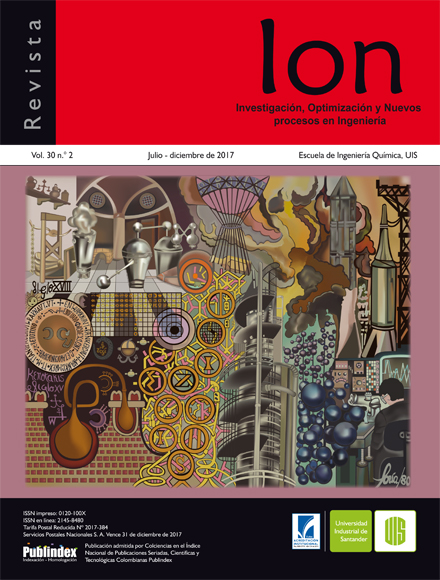Synthesis and characterization of Cu type catalysts supported on MgO, SiO2, ZnO, and Al2O3 applied to the hydrogenolysis of glycerol
Published 2018-05-06
Keywords
- glycerol,
- hydrogenolysis,
- 1,2-propanediol,
- Cu catalyst,
- incipient wet
How to Cite
Abstract
In this study the conversion of glycerol to 1,2-propanediol using Cu/MgO, Cu/SiO2, Cu/ZnO and Cu/ Al2O3 catalysts with 10 and 20% Cu contents were evaluated. The copper catalysts were obtained by the incipient wet impregnation method (IWI), using as a precursor a 1M trihydrate copper (II) nitrate solution. The characterization of the catalysts was carried out by the techniques of infrared spectroscopy, solving the characteristic signals at 1633cm-1 and 1383cm-1 indicating the presence of nitrates, whereas by X-ray diffraction it is possible to show the corresponding characteristic peaks to the planes of the tenorite (1 1 -1) and (1 1 1), at the 2θ angles of 35.6 ° and 38.7 ° respectively, indicating that the tenorite CuO is present in all solid systems in this study and that is the tenorite the active phase for transformation of glycerol. On the other hand, transmission electron microscopy (TEM) allowed to confirm the presence of particles with sizes varying between 100 and 800 nanometers depending on the support. This study demonstrates that the conversion of 84% glycerol and the selectivity towards the 1,2-propanediol around 52% is favored when using the catalyst based on Cu20%/MgO activated at 573K at the reaction conditions of 473K and 20bar, whereas when this same catalyst is activated at 623K under the same reaction conditions, the selectivity is increased to 63% with a decrease in conversion to 65% which in comparison with the other catalytic systems shows that this Cu20%/MgO is the best catalyst in this study.
Downloads
References
[2] Vasiliadou ES, Eggenhuisen TM, Munnik P, de Jongh PE, de Jong KP, Lemonidou AA. Synthesis and performance of highly dispersed Cu/SiO2catalysts for the hydrogenolysis of glycerol. Appl. Catal. B. Environ. 2014;145:108-19.
[3] Vanama PK, Kumar A, Ginjupalli SR, Komandur VRC. Vapor-phase hydrogenolysis of glycerol over nanostructured Ru/MCM-41 catalysts. Catal. Today. 2014.
[4] Dasari M, Kiatsimkul P, Sutterlin WR, Suppes GJ. Low-pressure hydrogenolysis of glycerol to propylene glycol. Appl. Catal. A-Gen. 2005;281:225–31.
[5] Sun D, Yamada Y, Sato S, Ueda W. Glycerol hydrogenolysis into useful C3 chemicals. Appl. Catal. B. Environ. 2016;193:75–92.
[6] Nakagawa Y, Tomishige K. Heterogeneous catalysis of the glycerol hydrogenolysis. Catal. Sci. Technol. 2011;1:179-90.
[7] Niu L, Wei R, Yang H, Li X, Jiang F, Xiao G. Hydrogenolysis of glycerol to propanediols over Cu-MgO/USY catalyst. Chin. J. Catal. 2013;34:2230–5.
[8] Chen L, Ren S, Ye XP. Lactic acid production from glycerol using CaO as solid base catalyst. Fuel Process. Technol. 2014;120:40–7.
[9] Purushothaman RKP, van Haveren J, van Es DS, Melián I, Meeldijk JD, Heeres HJ. An efficient one pot conversion of glycerol to lactic acid using bimetallic gold-platinum catalysts on a nanocrystalline CeO2 support. Appl. Catal. B Environ. 2014;147:92–100.
[10] Montes V, Checa M, Marinas A, Boutonnet M, Marinas JM, Urbano FJ, Järas S, Pinel C. Synthesis of different ZnO-supported metal systems through microemulsion technique and application to catalytic transformation of glycerol to acetol and 1,2-propanediol. Catal. Today. 2014;223:129–37.
[11] Sun D, Yamada Y, Sato S. Effect of Ag loading on Cu/Al2O3 catalyst in the production of 1,2-propanediol from glycerol. Appl. Catal. Gen. 2014;475:63–8.
[12] Durán D, Ojeda M, Granados M, Fierro J, Mariscal R. Stability and regeneration of Cu–ZrO2 catalysts used in glycerol hydrogenolysis to 1,2-propanediol. Catal. Today. 2013;210:98–105.
[13] Delgado SN, Vivier L, Especel C. Polyolhydrogenolysis on supported Pt catalysts: Comparison between glycerol and 1,2-propanediol. Catal. Commun. 2014;43:107–11.
[14] Panyad S, Jongpatiwut S, Sreethawong T, Rirksomboon T, Osuwan S. Catalytic dehydroxylation of glycerol to propylene glycol over Cu–ZnO/Al2O3 catalysts: Effects of catalyst preparation and deactivation. Catal. Today. 2011;174:59-64.
[15] Nakamoto K, Wiley J, Wiley A. Infrared and Raman Spectra of Inorganic and Coordination Compounds. 6 ED. USA, New York; 1978.
[16] Claudio L, Garcia E, Rondon J, Melendez H, Perez P, Del Castillo P. Preparation and characterization of mixed nanostructured oxides supported on MgO. J. Advances in Chemistry.2010; 005.
[17] Maris EP, Ketchie WC, Murayama M, Davis RJ. Glycerol hydrogenolysis on carbon-supported Pt-Ru and Au-Ru. J. Catal. 2007;251:281–94.

